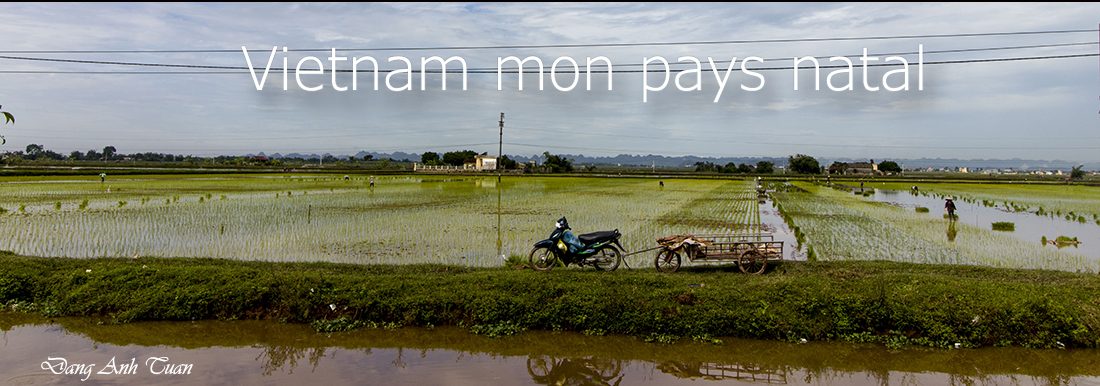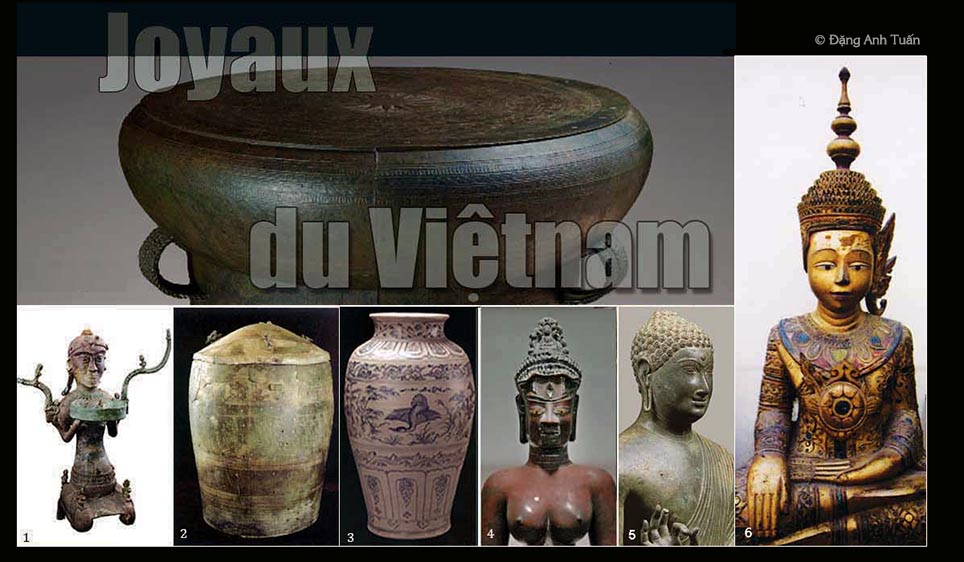Etant la terre des civilisations, le Vietnam recèle au bout d’un siècle de fouilles archéologiques entamées d’abord par les archéologues français puis par ceux du Vietnam, un grand nombre de trouvailles dont certaines se distinguent par leur beauté incommensurable et par leur originalité exceptionnelle. Certains spécimens deviennent les joyaux de la nation et représentent l’une des trois civilisations découvertes au Vietnam. On peut les admirer dans les musées de l’histoire du Vietnam (Hànội, Đà Nẵng, Sàigon, An Giang). Parmi ces objets exhumés, on peut citer le célèbre tambour de bronze Ngọc Lũ, symbole de la civilisation dongsonienne. Il est suivi ensuite par
1°) Le lampadaire de la tombe n°3 de Lạch Trương, Đồng Sơn, Bronze, Hauteur: 0,33m. Musée de l’histoire de Hànội
2°) La situle Đào Thịnh de Yên Bái, Đồng Sơn, Bronze, Hauteur: 81cm. Musée de l’histoire de Hànội. Cette situle évoque le culte de la fertilité. (Văn hóa phồn thực)
3°) Le vase en céramique (gốm) à décor de paysage peint en couleur « bleu et blanc » provenant de l’épave de l’île Cù Lao Chàm (Quảng Nam). On y trouve à travers le motif du cygne les traits de l’âme vietnamienne. Musée de l’histoire de Hànội.
4°) La statue de la bodhisattva Tara (culture chame), bronze incrusté d’or, d’argent et de pierres semi-précieuses. Hauteur: 1,15m. Style Đông Dương (Milieu du du IXème siècle). Musée de Đà Nẵng.
5°) Statue de bouddha, Đồng Dương, Quảng Nam (VIIIe-IXè siècle) . Bronze H:119cm, L:38cm. Cette statue en bronze, fondue à cire perdue a été retrouvée presque intacte au moment de sa découverte. Son style reste énigmatique. Musée de l’histoire (Saigon).
6°) La statue du Bouddha assis dans la position de la prise de la terre à témoin (bắt ấn địa xúc) (bhūmisparśa-mudrā). Civilisation Óc Eo. Musée de An Giang.
Galerie des photos
Bảo vật Quốc Gia
During a century of archaeological excavations initially started by French archaeologists and then by those of Vietnam, the land of civizilations Vietnam holds a large number of archeological finds, some of which are distinguished by their incommensurable beauty and their exceptional originality. Some specimens become the jewels of the nation and represent one of the three civilizations discovered in Vietnam. One can admire them in the history museums of Vietnam (Hànội, Đà Nẵng, Sàigon, An Giang). Among these objects exhumed, one can cite the famous bronze drum Ngọc Lũ, symbol of Đồng Sơn civilization. It is followed by
1°) The floor lamp found in the tomb n°3 of Lạch Trương, Đồng Sơn, Bronze, Heigth: 0,33m. Museum of Hànội
2°) The situla Đào Thịnh of Yên Bái, Đồng Sơn, Bronze, Heigth: 81cm. Museum of Hànội. This situla evoke the cult of fertility. (Văn hóa phồn thực)
3°) The ceramic vase (gốm) with an attractive decoration of landscape painted in color « blue and white » . It was retrieved from the wreck of Cù Lao Chàm island (Quảng Nam). Thanks to the swan motif, one discovers the traits of Vietnamese soul. History museum of Hànội.
4°) The statue of Tara bodhisattva (Cham culture), in bronze overlaid with or, silver and semi-precious stones. Heigth: 1,15m. Đông Dương style (Middle of 9th century). Museum of Đà Nẵng.
5°) Buddha statue, Đồng Dương, Quảng Nam (8th-9th century) . Bronze H:119cm, L:38cm. This bronze statue in molten wax was found almost intact at the discovery time. Its style remains enigmatic. History museum of Saigon.
6°) The statue of Buddha making the mudra of taking the earth as witness with the right hand (bắt ấn địa xúc) (bhūmisparśa-mudrā) . Óc Eo civilization. Museum of An Giang.

